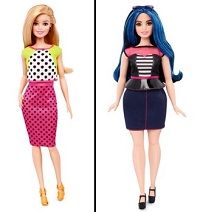Article
Barbie Puts on Weight: Is that a Problem?
Author(s):
Mattel has announced a new plus-sized Barbie line. What does that say about attitudes toward obesity? Psychologists weigh in.

(Image from Barbie.com)
Diversity is the name of the game when it comes to Mattel’s newest additions to the Barbie family. The company announced today that the iconic doll with the impossible measurements now comes in plus-sized editions—as well as tall and petite.
“If this shows plus-sized people are more valued now, that’s a good thing,” said Simon Rego, PsyD., director, Psychology Training, Psychiatry and Behavioral Sciences at the Montefiore Health System in the Bronx, NY.
His hope is that the company is not just engaged in a marketing ploy but is “normalizing what is realistic.”
Rego said he remembers when advocates concerned about young girls comparing themselves unfavorably to traditional Barbie took the doll’s measurements and blew them up to human size. “It wasn’t compatible with life,” he said.
If Barbie were real she would be 5’9” and weigh 110 pounds, putting her body mass index (BMI) at 16.25 — which meets the criteria for anorexia. A living breathing human Barbie would also have a 39” bust, 18” waist, 33” hips, and wear a size three shoe.
Clearly that is not realistic. Also on the diversity front, Mattel today said it has made a wide range of big changes to the Barbie image. Consumers will now have a choice of dolls with seven skin tones, 22 eye colors, and 24 hairstyles as well. So kids, or grownups, who’ve always wanted a curvy Barbie with blue hair and greens eyes, are in luck.
But not all adolescent psychiatrists were enthused.
While the diversity is empowering to kids who never had a doll that looked quite like them, there are worrisome aspects to having an obese Barbie.
Scott Krakower, DO, an adolescent psychiatrist and assistant professor of psychiatry at Hofstra Northwell School of Medicine, said he is perplexed at curvy Barbie’s arrival. He blames adolescent obesity in part on poor parenting decisions, such as regularly taking their kids to fast food chains.
- Get trending & breaking health news to your email --> here!
“Maybe they’ll start putting these dolls in Happy Meals,” Krakower joked. He would not recommend that a parent buy one for an adolescent struggling with her weight.
“Why can’t they just make dolls with regular proportions?” Krakower continued, adding that the traditional Barbie’s proportions are extreme.
According to Mattel, the main reason for expanding the Barbie line was to reach girls all around the world. In a news release the company said it wants to help all kids find a doll that speaks to them.
Krakower said, health is a larger and more important issue than expanding consumer choice in dolls.
“Being heavy has an impact on people’s self-esteem, but being obese is not healthy,” he said, “giving someone a doll that’s overweight won’t make that better.”




